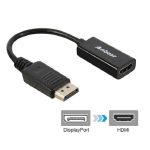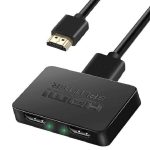Contents
- 1 Different Soundbar Connection Options
- 2 Step-by-Step Connection Using HDMI ARC
- 3 The Role of Optical Cables
- 4 Advantages of Wireless Soundbar Connection
- 5 Troubleshooting Common Soundbar Connection Issues
- 6 Enhancing Your TV Audio Experience
- 7 FAQs in Soundbar and TV Connections
- 8 Beyond the Basics: Exploring Advanced Soundbar Features
Different Soundbar Connection Options
How to connect soundbar to tv with hdmi? Connecting your soundbar to your TV enhances your audio experience. There are several ways to do this.
HDMI Cable Connection
Using an HDMI cable is simple. One cable carries both audio and video. Plug one end into your TV and the other into your soundbar.
Optical Cable Connection
An optical cable is an alternative to HDMI. Connect it from your TV’s optical out to your soundbar’s optical in.
Bluetooth Connectivity
For wireless connection, use Bluetooth. Pair your soundbar with your TV’s Bluetooth setting.
AV Adapter Solution
If HDMI or optical aren’t an option, an AV adapter can link your soundbar to your TV.
Step-by-Step Connection Using HDMI ARC
Preparing Your Equipment
Before starting, gather your HDMI cable and ensure all devices are powered off. Check that your TV and soundbar both support HDMI ARC, which is essential for this setup. Locate the HDMI ARC ports on each device; these are specifically labeled ‘ARC’ on most TVs and soundbars.
Connection Process
- Connect one end of the HDMI cable to the HDMI ARC port on your TV.
- Plug the other end into the HDMI ARC port on your soundbar.
- Power on both the TV and soundbar, preparing for the audio and visual sync.
- Change the source input on your soundbar to ‘HDMI ARC,’ if necessary.
Adjusting the TV Settings
After connecting with HDMI ARC:
- Go to your TV’s sound menu using the remote.
- Select ‘Sound Output’ or similar settings.
- Choose ‘HDMI ARC’ as the output mode.
- If available, enable CEC (Consumer Electronics Control) for easy control with one remote.
These steps should significantly improve your audio experience by utilizing the audio-return channel.

The Role of Optical Cables
When to Use Optical Cables
Optical cables provide a reliable audio connection between your TV and soundbar. These cables are ideal when HDMI ARC is not an option. They are perfect for older TVs without HDMI ports. Optical cables also bypass TV’s lower quality DACs for better sound. They ensure a pure digital audio signal without electromagnetic interference. Use optical cables for clear and crisp audio performance.
Connecting Your Soundbar with Optical Cable
To connect with an optical cable, follow these steps:
- Locate your TV’s optical output and soundbar’s optical input.
- Take your optical cable and remove the protective caps.
- Insert one end into the TV’s optical out.
- Plug the other end into the soundbar’s optical in.
- Turn on your TV and soundbar.
- Select the optical input on your soundbar, if needed.
Check your TV settings to ensure it’s set to output audio via optical. Enjoy improved sound quality instantly with this simple setup.
Advantages of Wireless Soundbar Connection
The wireless connection of a soundbar offers a clean, cable-free setup. It eliminates clutter and the need to hide wires, providing a streamlined look for your entertainment space. Additionally, wireless technology enables flexible placement of your soundbar, so you can optimize sound quality without being constrained by cable lengths.
Setting Up Bluetooth Connectivity
To connect via Bluetooth, follow these steps:
- Ensure your soundbar is in pairing mode.
- On your TV, go into the Bluetooth settings menu.
- Select the soundbar from the list of available devices.
- Confirm the pairing on both devices, if prompted.
- Enjoy your wireless audio connection immediately after they pair.
Remember to check if both your soundbar and TV support Bluetooth connectivity before you start.
Enhancing Experience with TCL Soundbars
TCL soundbars make setting up Bluetooth effortless with user-friendly interfaces. Once paired, you can adjust the audio settings on the TCL soundbar to suit your preferences. Whether watching movies or playing games, the right settings can significantly enhance your listening experience. TCL’s commitment to quality ensures your living room transforms into a personal theater with outstanding sound.

Troubleshooting Common Soundbar Connection Issues
Encountering some hiccups when connecting your soundbar to your TV can be common. Here’s how to address the most frequent issues.
Resolving HDMI ARC Complications
If you’re facing issues with HDMI ARC connections, try these steps:
- Check the HDMI cable is plugged into the correct ‘ARC’ ports on both devices.
- Confirm HDMI CEC is activated in your TV settings.
- Ensure both devices are powered on and have the correct input source selected.
- If the setup still doesn’t work, try using a different HDMI cable as it may be faulty.
Fixing Optical Cable Connection Problems
For optical cable troubles, these fixes can often help:
- Verify that the optical cable is securely connected to both the TV and soundbar.
- Remove and re-insert both ends of the cable to ensure a snug fit.
- Ensure your soundbar is set to the optical audio input.
- If it still isn’t working, inspect the cable for bends or damage—consider replacing it if necessary.
Overcoming Bluetooth Pairing Challenges
When Bluetooth isn’t pairing correctly, you might want to:
- Check that your soundbar is in Bluetooth pairing mode and is visible to other devices.
- Confirm that the TV’s Bluetooth feature is on and searching for devices.
- Try moving the soundbar closer to the TV to strengthen the signal.
- Restart both the soundbar and TV, as this can resolve temporary connection issues.
By following these tips, most connection problems can be resolved quickly. Remember to consult your soundbar and TV manuals for model-specific guidance if issues persist.
Enhancing Your TV Audio Experience
Connecting a soundbar to your TV is just the first step. To truly enhance your audio experience, consider soundbar placement and settings.
Soundbar Placement Tips
The location of your soundbar can impact sound quality. Follow these tips for optimal placement:
- Place the soundbar directly below your TV.
- Make sure the soundbar is at ear level when you’re seated.
- Avoid placing it inside a cabinet to prevent sound blockage.
- For soundbars with subwoofers, place the subwoofer near the soundbar but it can be off to the side.
Correct placement ensures clear and balanced sound throughout your room.
Adjusting Soundbar Settings
After connecting your soundbar, fine-tune its settings:
- Use the soundbar’s remote to access the audio menu.
- Select the sound mode that fits what you’re watching or listening to.
- Adjust the bass or treble to your preference.
- Set up any voice enhancement features for clearer dialogue.
- If your soundbar has a room calibration feature, use it.
Testing and adjusting these settings will bring out the best in your soundbar’s performance. Enjoy richer sound and a more immersive experience every time you watch TV.

FAQs in Soundbar and TV Connections
Navigating soundbar and TV connections can raise questions. We cover some common FAQs.
Understanding Roku TV’s Private Listening Feature
Roku TVs, linking audio wirelessly to a soundbar, use a feature called Private Listening. Use Roku remote or the Roku app on mobile devices for Private Listening.
Why Some TVs Lack Headphone Jacks
To simplify the user ecosystem, manufacturers sometimes remove lesser-used features, like headphone jacks. They promote seamless integration of proprietary services.
Switching TCL TV From Headphone to Soundbar Mode
Switch from headphones to soundbar by changing settings. Select ‘Audio Settings’ on your TCL TV menu, choose ‘TV Speakers’, and opt for ‘External Speakers Only’.
Beyond the Basics: Exploring Advanced Soundbar Features
Modern soundbars offer a range of advanced features that can further enhance your audio experience. Here are some notable features to explore:
Voice Enhancement
- Dialogue Clarity: Some soundbars have voice enhancement features that make dialogue clearer and easier to understand, especially in movies and TV shows with complex audio mixes.
Night Mode
- Reduced Dynamic Range: Night mode compresses the dynamic range of the audio, reducing the difference between loud and quiet sounds. This is helpful for late-night viewing when you don’t want to disturb others.
Adaptive Sound
- Content Optimization: Adaptive sound modes analyze the audio content and automatically adjust the soundbar’s settings to provide the best possible sound for movies, music, or games.
By exploring these advanced features and optimizing your soundbar setup, you can create a truly immersive and personalized audio experience that elevates your home entertainment to new heights.


